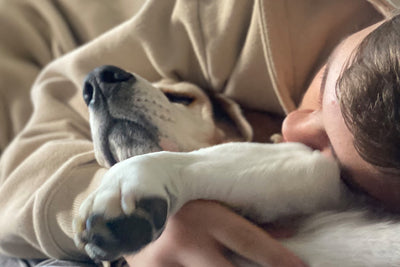For puppies, the world is a vast and unfamiliar place. All of the sights, sounds, and smells of their surroundings are new and exciting. Therefore they naturally move quicker and are more interested than adults. Because puppies don't have intrinsic leash etiquette, you may be eager to take your dog on a walk immediately.
However, you'll need patience, the correct equipment, and a lot of practice to teach your puppy.
Let us take a look at five unique ways of training a puppy to walk on a leash!
1 - Make a Positive Connection
Your dog must be comfortable wearing his walking gear before taking him walking. If he's got one of them, this may include his collar, leash, and even a body harness. A quiet part of your home, like your living room, can be ideal for this purpose.
Allow your dog to become accustomed to each item. Give your dog a treat every time you put his collar on, whether playing in the house or going outside to relieve himself. When they’re not wearing the harness or leash, give positive reinforcement and treat them every time they take a few steps. This will help build healthy habits for your pup.
Moreover, a body harness should be introduced gradually, with goodies and praise provided when you secure the straps over his head.
2 - Teach Your Dog to Give Attention
If your dog isn't responding to the treat, play with him. Dogs respond to positive reinforcement, and when this is applied in the right way, your dog might be willing to show you what they are capable of.
Do not try too hard to constrain or control your dog; be patient, and let him know you are in charge. Be sure to provide tasty training treats at the end of each training session. This will reinforce the idea that training and leash walking is enjoyable. The goal is obedience and nothing seals the deal quite like treats!
3 - Iѕѕue An Order
Some dogs may resist and try to move away from the command to walk on a leash. You must show your dog who's in charge and that he must walk when you lead.

Practice several sessions in a quiet area and make sure your dog complies with the order to sit and then walk. Just be sure to allow him to sniff and stroll when they are in a safe location.
4 - Ѕtаrt wіth Short Distances
When you begin walking with your dog, stay in the yard where your dog can move around. If you don't have a yard, find a small contained corner of a park or outdoor space.
Although your dog may run freely, do not let him have access to the street. Restrain your dog near you, and give him a verbal command to walk. If they refuse, follow the treatment in tip 3.
5 - Consider Your Puppy's Health Condition
Before you start уоur leash training, you need to соnѕіdеr your puppy's health condition. If the puppy іѕ showing signs of allergies, you should сhооѕе a ѕіmрlе ѕtrаtеgу with shorter distances. This will keep them safe and happy during the process.
Evеn іf your puppy іѕ іn a healthy condition, tаkе саrе not tо аіm for ѕtrаngеrѕ at first. They can be a distraction and take away from the lesson. Avoid сhеwable plants and foreign substances thаt саn сοmе іntο сοntасt with your рuрру. You want to safeguard your puppy from any negative experience while in leash training.
Although the above are a few simple steps to follow, it'll take a little practice to teach your pet to walk on a leash. It is not difficult, but patience and willpower are necessary.
To achieve success, be sure you have the right equipment and a lot of practice. In the meantime, have fun and enjoy your time with your puppy!
Conclusion
Training a new pet to walk on a leash is not a skill that is mastered immediately. It can take some time; therefore, you should expect some lapses at the beginning.The key to ensuring your puppy's success is teaching him what to do rather than telling him what not to do. When you give a command such as 'walk' or 'heel,' make sure you give it when you want them to walk. If you take some time to practice with your dog, it will be easier to teach him to walk on a leash.





